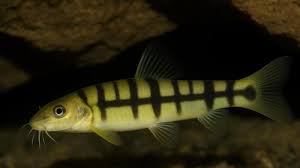Schistura densiclava:

A team from Gauhati University’s Department of Zoology recorded a new species of troglophilic loach, Schistura densiclava, in Meghalaya recently.
- It is a new species of cave-dwelling fish.
- The fish was found in Krem Mawjymbuina, a limestone cave near Mawjymbuin village in the East Khasi Hills district of Meghalaya, a region known for its complex limestone cave systems.
- Schistura densiclava was found deep inside Krem Mawjymbuin.
- Surrounded by dense forest and accessible only seasonally, the cave remains untouched by tourism or human activity, preserving its pristine condition.
- This discovery raises the number of known cave-associated fish in Meghalaya to six.
- Unlike many cave-adapted fish that lose their eyesight and pigmentation over generations of isolation, Schistura densiclava retains fully functional eyes and distinct body coloration.
- This suggests the species is a troglophile — a type of organism that can live both in cave environments and outside.
- It belongs to the loach family (Nemacheilidae) and is adapted to life in the cool, low-light conditions of the cave’s underground stream.
- It displays a striking pattern of 14–20 black bars across a pale yellow-green body and a thick black stripe at the base of its dorsal fin — a feature that inspired its name, “densiclava,” which means “thick stripe” in Latin.
- The fish also shows clear differences between males and females.
- Males tend to have slimmer bodies, irregular markings on their flanks, and slightly puffier cheeks.
- Females are generally plumper, with more regular body markings.




